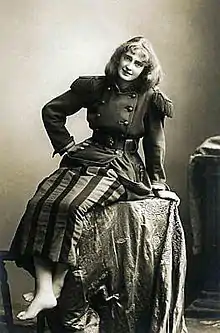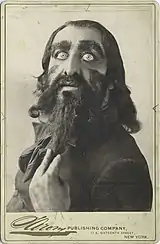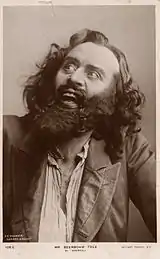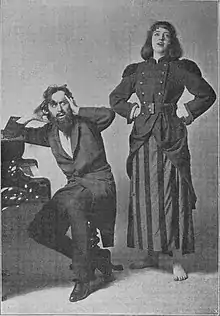
Trilby is a stage play by Paul M. Potter based on the 1894 novel Trilby by George du Maurier. In the play, a young Irish woman, Trilby O'Ferrall, falls under the control of Svengali, who uses hypnosis to make her abandon her fiancé and become a singer.
The play debuted in Boston, Massachusetts in March 1895, where the role of Svengali was created by American actor Wilton Lackaye at the Park Theatre.[1] It was a success in England as directed, produced by and starring Herbert Beerbohm Tree as Svengali, with Dorothea Baird in the title role, opening at the Haymarket Theatre in October 1895.
Background

While touring the United States in the Spring of 1895 Tree heard of the success of an adaptation of du Maurier's novel by Paul M. Potter being performed by the company of theatrical manager Albert Marshall Palmer at the Boston Museum. He sent his half-brother and agent Max Beerbohm to see the play and report back on it. Max Beerbohm stated that the play was "absolute nonsense" and would be a failure in London. Tree dismissed the play from his mind until he had a night free and went to see the play in Buffalo, New York,[2] with Wilton Lackaye in the role of Svengali and Virginia Harned playing the title role.[3]
Tree immediately bought the British rights to the play and on his return to London mounted his own production, firstly at the Theatre Royal in Manchester on 7 September 1895 and finally on 30 October 1895 at the Haymarket Theatre in London. The two Manchester performances secured British copyright for Potter's adaptation. Tree's company then toured, performing Trilby at the Grand Theatre, Leeds 11–14 September; at the Theatre Royal, Glasgow 16 and 20 September; at the Royal Lyceum Theatre in Edinburgh 23–27 September; at the Royal Court Theatre in Liverpool 30 September-5 October; at the Gaiety Theatre in Dublin 7–12 October; at the Tyne Theatre in Newcastle 14–19 October; and at the Theatre Royal in Birmingham 21–26 October.[4]

The London premiere on 30 October 1895 was the company's first presentation at the Haymarket since returning from their American tour. Potter's original script was revised for Tree, who himself played Svengali, giving even more significance to the role of Svengali in the play than in the novel.[5] For the lead role of Trilby O'Ferrall he chose the 20-year-old Dorothea Baird, who had made her London debut in 1894 as Hippolyta in A Midsummer Night's Dream. Tree directed the production. The musical director was Raymond Rôze, and the choreographer was John D'Auban. The play was a huge financial success, and from the profits Tree built Her Majesty's Theatre. Fifty years later Max Beerbohm persisted in his evaluation of the play, telling his biographer Samuel Behrman, "I was right about Trilby."[2]

The play was revived many times, including at the Apollo Theatre in the 1920s. It became so popular that it was travestied, including as A Model Trilby; or, A Day or Two After Du Maurier (1895) by Charles H. E. Brookfield and William Yardley, with music by Meyer Lutz, at the Opera Comique, produced by the retired Nellie Farren.[6] In America it was parodied in 1895 as Thrillby, to a book by Joseph W. Herbert and a score by Frank Osmond Carr.
Tree filmed the play in 1914, which was released as Trilby; he was the only member of the original cast to appear. The 1915 American film Trilby starred Wilton Lackaye and Clara Kimball Young. An adaptation of the novel was broadcast as a BBC Play of the Month in the UK on 25 January 1976.
Synopsis


The action is set in Paris during the 1850s.
Act I
Three British art students share a studio in Paris. 'Taffy' Wynne and Sandy McAlister are attracted by the young Irish model Trilby O'Ferrall, but 'Little Billee' Bagot wants to marry her, even though he is upset by her posing nude. She refuses him because she thinks herself unworthy of him. Svengali, a neighbouring Jewish piano player, demonstrates his hypnotic powers over Trilby, curing her migraine. He claims he can train her voice, even though she is tone deaf.
The Act ends with Taffy persuading Trilby to accept Little Billee's proposal.
Act II
The night before the wedding Little Billee's mother arrives unannounced. Svengali tells her of the marriage and poisons her against Trilby. Mrs Bagot forbids the marriage, so Little Billee's friends suggest that instead he should elope with Trilby; however, when Svengali is alone with Trilby he hypnotizes her into writing a letter of farewell. When his friend Gecko protests at his actions Svengali suffers a heart attack from which he recovers and leaves with Trilby. When Billee and his friends return he discovers the letter and is heart broken.
Act III
Five years later the friends return to Paris and attend the Circus des Bashibazouks where they are horrified to discover 'Madame Svengali', the famous concert soprano is actually Trilby who they later discover is in a trance induced by Svengali. Taffy attacks Svengali as he follows Trilby to the concert platform, and Svengali has a heart attack and dies cursing. At his death Trilby's voice returns to its former tuneless state, and she is led into the foyer in a state of collapse.
Act IV
Trilby is returned to the old studio in an attempt to help her recover physically and mentally from her ordeal. She recalls nothing of her experiences with Svengali or her singing career and Billee proposes to her again. At Christmas time a parcel is delivered for Trilby, and on opening it she discovers it is a portrait of himself ordered by Svengali. As soon as she sees the portrait Trilby falls into a trance, sings a few notes of her favourite ballad and collapses and dies in the arms of Little Billee.[4]
Cast list
| Role | Boston Museum 4 March 1895 and Garden Theatre, New York 15–20 April 1895[4] | Theatre Royal, Manchester 7 September 1895 and Haymarket Theatre, London 30 October 1895[4] |
|---|---|---|
| Svengali | Wilton Lackaye | Herbert Beerbohm Tree |
| Talbot "Taffy" Wynne | Burr McIntosh | Edmund Maurice |
| Alexander McAlister, “The Laird of Cockpen” | John Glendinning | Lionel Brough |
| William Bagot, “Little Billee” | Alfred Hickman | Patrick Evans |
| Gecko, second violin at the Gymnase | Robert Faton Gibbs | C.M. Hallard |
| Duc de la Rochemartel, “Zouzou” | Leo Ditrichstein | Herbert Ross |
| Theodore de la Farce, “Dodor | Alex L. Gisiko | Gerald du Maurier |
| Antony, art student | W.M. de Silke | Berte Thomas |
| Lorimer, art student | Edwin Brandt | Gayer Mackay |
| Rev. Thomas Bagot | Edward L. Walton | Charles Allan |
| Colonel Kaw, a theatrical manager | Reuben Fax | E. Holman Clark |
| Trilby O’Ferrall, an artist’s model | Virginia Harned | Dorothea Baird |
| Mrs. Bagot | Rosa Rand | Frances Ivor |
| Madame Vinard, a concierge | Mathilde Cottrelly | Rosina Filippi |
| Angèle, a grisette | Grace Pierrepont | Cicely Turner |
| Honorine, a grisette | Lucile Nelson | Agnes Russell |
| Musette, a grisette | Josephine Bennett | Sadie Wigley |
| Ernestine, a grisette | Sybil Erlyn | |
| Mimi, dancer from the Salle Valentino | Menta Elmo | Olive Owen |
| La petite Noisette, dancer from the Salle Valentino | Winnie Leon | |
| Hortense, dancer from the Salle Valentino | Madge Langton | |
| Desirée, dancer from the Salle Valentino | Helen Graeme |
References
- ↑ "Trilby Makes Her Debut on the Stage". The Boston Globe. 12 March 1895. p. 4 – via Newspapers.com.
- 1 2 Hall, John N. Max Beerbohm Caricatures, Yale University Press (1997) p. 79 Google Books
- ↑ Brown, A History of the New York Stage, pp. 524–525.
- 1 2 3 4 Herbert Beerbohm Tree Collection, HBT/00030/3 to 00030/6, Bristol Theatre Collection, University of Bristol
- ↑ Ellis, Alfred "Trilby, that's my name...", The Illustrated London News, 21 September 1895, p. 357
- ↑ The Times, 18 November 1895, p. 3